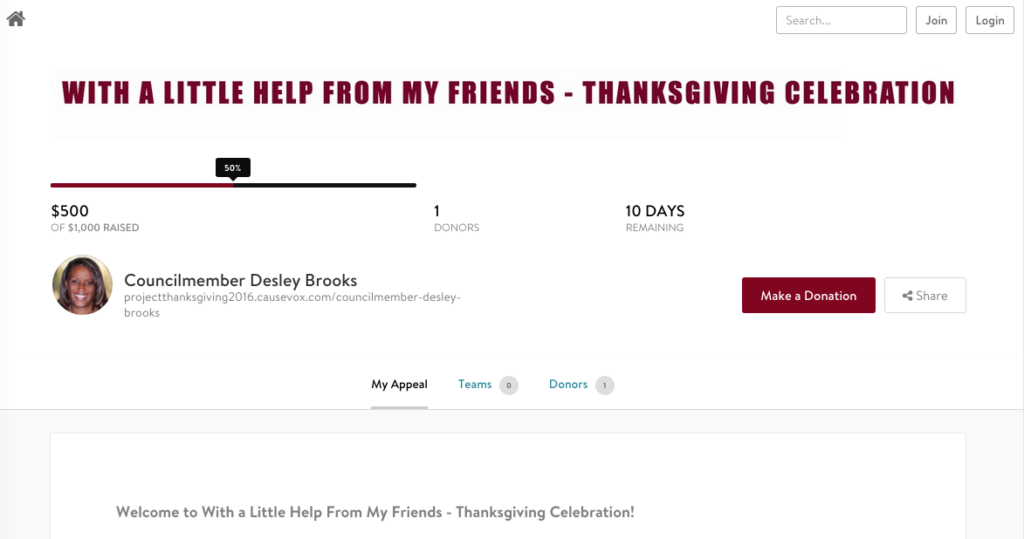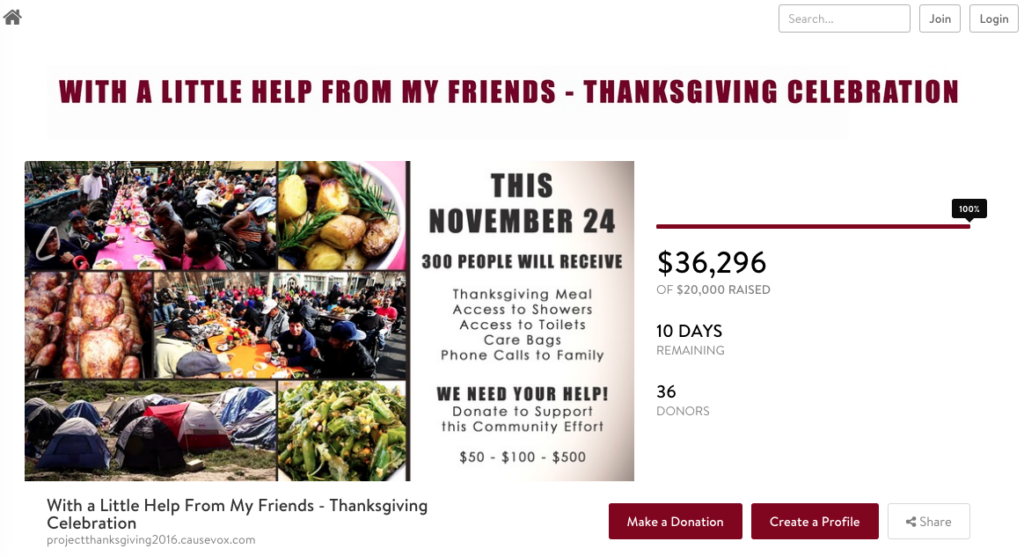You’ve run traditional campaigns, email campaigns, and have done enough special events to keep your staff (and donors) busy. But the work of a fundraiser is never done. You always have to be thinking about how to keep the momentum going.
Thankfully, after all that fundraising, you likely have a group of loyal supporters ready and willing to step up and support your cause.
If this sounds like your nonprofit or charity, then consider peer-to-peer fundraising for your next campaign.
What Is Peer-To-Peer Fundraising?
Peer-to-peer fundraising is a type of crowdfunding that uses your current donors, volunteers, and other connections to fundraise for your nonprofit or charity.
Personal fundraisers participate by creating personal or team pages that drive their networks to give to your cause, expanding your reach and helping you to acquire new donors in the process.

What Is A Peer-to-Peer Fundraising Platform?
CauseVox is a peer-to-peer fundraising platform, to manage your main campaign website and any additional personal and team fundraising pages.
CauseVox’s peer-to-peer fundraising platform provides customers with a hub where they can organize their campaigns, including a customized, tailored site (so you can maintain your organization’s branding), the option to create an unlimited number of personal fundraising pages, social media and email sharing functions, and dedicated customer support.
Why Would You Choose To Run A Peer-To-Peer Fundraiser?
There are many reasons why a nonprofit or charity decides to run this type of campaign. Including:
- Expanding your reach to the networks of your current supporters (and convert those people into loyal donors)
- Raising up to 2x more than through traditional fundraising techniques
- Engaging your current supporters
- Diversifying your fundraising techniques
- Empowering your supporters that want to “do something” for your cause
Is Peer-To-Peer Fundraising Right For Your Nonprofit Or Charity?
Does your nonprofit or charity have the resources to run a successful peer-to-peer fundraising campaign? Answer these questions to determine if this strategy is right for your organization.
“Does your nonprofit or charity have the resources to run a successful peer-to-peer fundraising campaign?” tweet this
1. Do You Have Current Supporters Willing To Fundraise On Your Behalf
The first thing you’ll need to run a peer-to-peer fundraiser is people to act as personal fundraisers.
If you’re unsure that folks would be willing to participate, start by gauging support. Reach out to your current list of board members, volunteers, donors, staff, and other stakeholders with the campaign idea and ask them to complete a short survey about whether they’d like to take part.
Those nonprofits and charities with active and engaged supporters ready to act as personal fundraisers should ask these people to become team captains. These folks will act as your biggest champions by bringing more fundraisers into the fold and managing their performance.
2. Do You Need To Raise A Lot Of Money In A Short Amount Of Time?
Though there are some nonprofits and charities that run peer-to-peer fundraisers all year long, this fundraising technique often works best when organizations need to run a quick campaign.
Most organizations aim to run a campaign for 30-60 days. In fact, having a set start and end date helps to build momentum and create a sense of urgency.
To define your campaign length, simply add an end date as you create your peer-to-peer fundraiser with CauseVox. Your donors can view the number of days left in your campaign directly on your site.

3. Can You Rally Your Troops?
Next, you’ll to determine whether you have a cause that resonates with people beyond your current circle of supporters.
Ask yourself:
- What sets your nonprofit or charity apart from others?
- Why and how are you making change in the world?
- What needs still aren’t being met with your current budget/income?
- How much needs to be raised in order to meet those needs?
Then, use these prompts to formulate a campaign unique to your cause.
Maybe you’re part of a small nonprofit focused on youth development looking to fund a summer reading program. Or, you’re an environmental organization looking into the current wetland mitigation practices of your town. This main campaign focus will act as an umbrella that all personal and team fundraisers work under. From this campaign idea, fundraisers will share their own story and explain how it relates to your work.
If you think people will get excited to fundraise for your campaign, then peer-to-peer fundraising may be right for you.
“If you think people will get excited to fundraise for your campaign, then peer-to-peer fundraising may be right for you…” tweet this
4. Do You Have What It Takes To Manage Your Fundraiser?
Next, you must have resources available to your fundraisers to help get your fundraisers (and their donors) excited about the campaign.
Resources for your personal fundraisers include:
- A staff point-person that can answer questions, guide training, and provide feedback
- A user-friendly, affordable online fundraising platform that allows use of your own brand
- Prompts for sharing their own story on each personal fundraising page
- Images and videos with on-point messaging
- Logos to help maintain brand integrity and consistent messaging.
- Example call to action
- Other miscellaneous campaign information including goals, social media hashtags, your mission statement, etc.
A successful fundraiser is a prepared fundraiser, so give your supporters the tools they need to help you meet the goal.
“A successful fundraiser is a prepared fundraiser, so give your supporters the tools they need…” tweet this
5. Are You Able To Communicate Quickly?
A sure-fire way to lose future or recurring donors is to forget to communicate the results.
No matter if your organization is large or small or whether you’re dealing with a dozen or hundreds of fundraisers, you’ll need to dedicate some staff time to not only rally but support the fundraisers.
Use this time to maintain the main fundraising page and update the site with relevant campaign information. That way, you’ll be communicating with your supporters while creating an atmosphere of transparency and accountability.
Report campaign milestones, setbacks, and accomplishments on a blog, your website, through social media, or with an occasional email.
And don’t forget to designate a point person that can be onhand to answer fundraiser (and donor) questions!
6. Do You Have a Retention Plan For Your Newly Acquired Donors?
Getting new donors is one of the best results of a peer-to-peer fundraiser. But how do you retain those donors? Having a retention plan in place is necessary to continue building that relationship past the first donation
Try these best practices to retain donors acquired by peer-to-peer fundraising:
- After the automatic donation receipt/thank you letter is sent by CauseVox, send a second, personalized thank you
- Don’t ask for another gift right away
- Recognize that your donors are new and welcome them to the cause with an email that dives into your impact
- Ask them to connect on social media
- To help tailor future outreach, send a survey that asks about their communication preferences and interests.
- When you use CauseVox, you can add a recurring donation option to your online campaign
Remember, your new donor will require cultivation and engagement like donors acquired with other traditional fundraising methods.
Is peer to peer fundraising right for your nonprofit or charity? As you can see, the answer to this question depends on many factors, including the campaign timeline, whether you have supporters willing to fundraise for you, and if you have the resources to support a campaign of this type.
For some great example of peer-to-peer fundraising campaigns, check out World Bicycle Relief and World Help. Both of these organizations do a wonderful job of planning the campaign, rallying fundraisers, communicating impact, and spreading the word!
Has your nonprofit run a successful peer-to-peer fundraiser? Let us know why you made the decision in the comments below!




